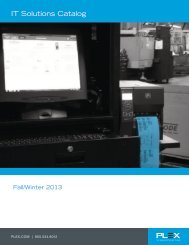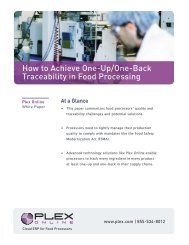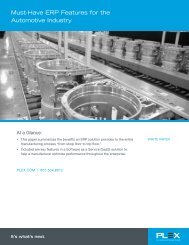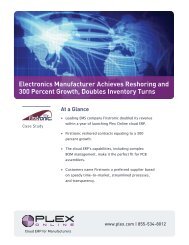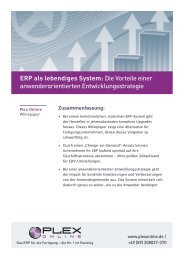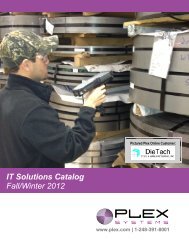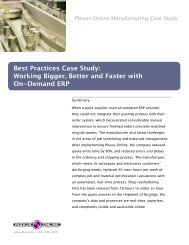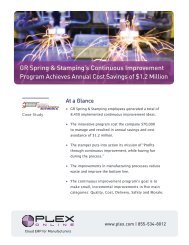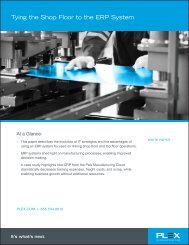Complete Integration - Plex Systems
Complete Integration - Plex Systems
Complete Integration - Plex Systems
You also want an ePaper? Increase the reach of your titles
YUMPU automatically turns print PDFs into web optimized ePapers that Google loves.
Honda certified a few months later.<br />
Results seen quickly<br />
“We started in early 2003 with the Parts Building module in the stamping area on the shop<br />
floor,” Patterson says. “It was adopted relatively easily by the shop floor employees. Initially<br />
there was concern that it would take longer to input the data than it would to write it down by<br />
hand, but once the shop employees realized how easy and efficient the system was, they<br />
embraced it.”<br />
The <strong>Plex</strong>us Manufacturing Execution/Shop Floor Control module is a powerful user interface for<br />
shop floor personnel to track and control a work station’s machine status, labor hours,<br />
production, inventory, tooling, etc. Soon after the module’s implementation, TOMASCO found<br />
that its overall equipment effectiveness (OEE) reports were consistent and accurate, eliminating<br />
hours of manual calculations by supervisors. The new system also automated the reporting of<br />
scrap and downtime.<br />
TOMASCO also began implementing the <strong>Plex</strong>us Purchasing, Purchase Receipt and Cycle Count<br />
of Raw Materials modules. At this point there was no effective inventory control for the coil<br />
room. By mid-2003 they had enhanced the communication between purchasing and production<br />
and eliminated the need for a “hot list” and the constant expediting of raw materials.<br />
The next targets were EDI, Shipping and Accounts Receivable. By early 2004 <strong>Plex</strong>us revised the<br />
EDI process and allowed TOMASCO to implement required Honda changes without the need for<br />
internal expertise or involvement. <strong>Plex</strong>us moved TOMASCO to a new platform without any<br />
problems.<br />
Machine Maintenance Goes From Reactive to Predictive, and Quality Scores<br />
Soar<br />
“Before we implemented the <strong>Plex</strong>us Maintenance module, we had improved our quality each year since<br />
2001 by 25.1 percent.” says Ken Keller, Senior Manager, Operations. “We went online with <strong>Plex</strong>us in<br />
March 2005, and our quality improvement jumped to 39.9 percent in a year when we were building parts<br />
for five new model launches, a record for new launches in one year—we usually have two. We could<br />
make these improvements because the information we now have access to allowed us to move from<br />
reactive maintenance to preventive maintenance. Now we’re moving from preventive maintenance to<br />
predictive maintenance.”<br />
Assistant Manager-QMS Deb Reining spent many weeks entering maintenance information and<br />
recommended preventive maintenance for every machine for which she had records. When TOMASCO<br />
went online, every employee could see the repair logs and preventive maintenance performed by<br />
machine. What they saw was that some machines had never been repaired, others broke down<br />
consistently, and still others did not receive the preventive maintenance they needed to optimize usage.<br />
Employees were encouraged to input maintenance requests for machines as soon as they identified the<br />
need, and they did so in droves. By enabling all employees to request maintenance, TOMASCO increased<br />
response time to maintenance requests by 81 percent.<br />
“The EDI capability in <strong>Plex</strong>us is a tremendous asset,” says Patterson. “Honda used a method<br />
called a ‘mailbox’ to send and receive EDI as part of its value added network. In a legacy




